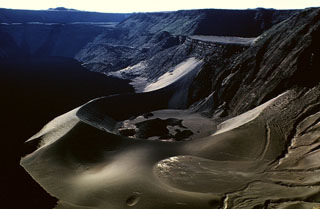Report on Cerro Azul (Ecuador) — 5 April-11 April 2017
Smithsonian Institution / US Geological Survey
Weekly Volcanic Activity Report, 5 April-11 April 2017
Managing Editor: Sally Sennert.
Please cite this report as:
Global Volcanism Program, 2017. Report on Cerro Azul (Ecuador) (Sennert, S, ed.). Weekly Volcanic Activity Report, 5 April-11 April 2017. Smithsonian Institution and US Geological Survey.
Cerro Azul
Ecuador
0.92°S, 91.408°W; summit elev. 1640 m
All times are local (unless otherwise noted)
IG reported that deformation data showed continued inflation after 20 March, indicating that the volume of the magma intrusion below Cerro Azul's SSE flank had increased. Seismicity decreased after 25 March possibly signifying a halt in the intrusion.
Geological Summary. Located at the SW tip of the J-shaped Isabela Island, Cerro Azul contains a steep-walled 4 x 5 km nested summit caldera complex that is one of the smallest diameter, but at 650 m one of the deepest in the Galápagos Islands. The shield volcano is the second highest of the archipelago. A conspicuous bench occupies the SW and west sides of the caldera, which formed during several episodes of collapse. Youthful lava flows cover much of the caldera floor, which has also contained ephemeral lakes. A prominent tuff cone located at the ENE side of the caldera is evidence of episodic hydrovolcanism. Numerous spatter cones dot the western flanks. Fresh-looking lava flows, many erupted from circumferential fissures, descend the NE and NW flanks. Historical eruptions date back only to 1932, but Cerro Azul has been one of the most active Galápagos volcanoes since that time. Solfataric activity continues within the caldera.
Source: Instituto Geofísico-Escuela Politécnica Nacional (IG-EPN)

